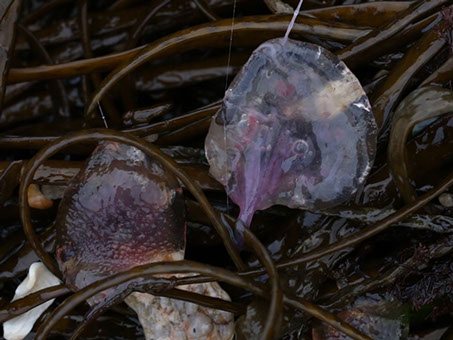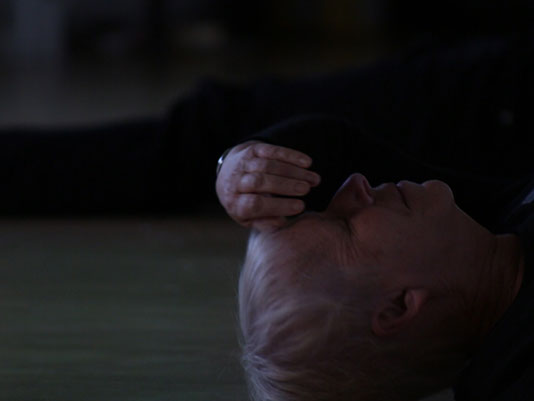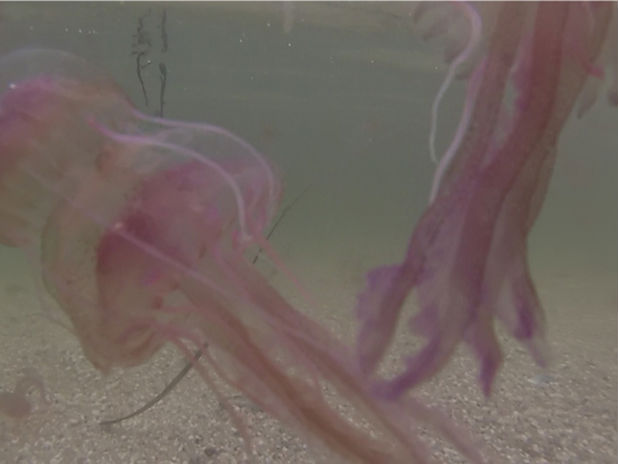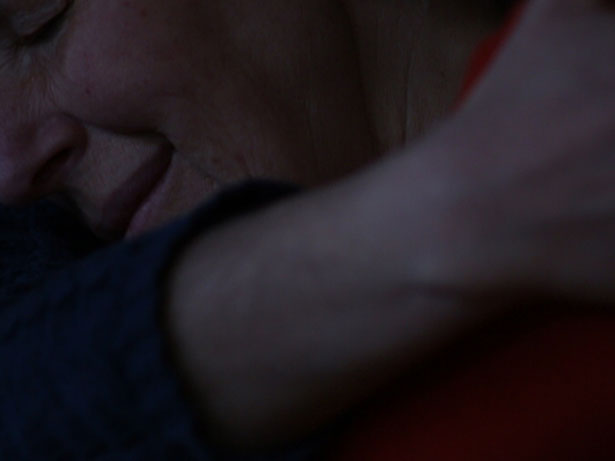An Exploration of Verbivocovisual Borders and Margins, 2015
Disappearing into land, 2015 - 18
Did I (sub-aqueous) in the Scilly Isles, put out a feeler? 2018
Interview with Adam Pugh, Director of Artists' Moving Image at Tyneside Cinema, 2019
Interview with Babette Mangolte and Louis Hartnoll, Moving Image Review & Art Journal (MIRAJ), 2019
Interview with Izzy Dubois & Phoebe Cripps, Young Artists in Conversation, 2019

Did I (sub-aqueous) in the Scilly Isles, put out a feeler? (1)
2018, written for Orlando Magazine, Issue 03: Beyond the Body
A cap, like water, transparent, fluid yet with definite body
Exercise 1:
Lie prostrate on the ground, arms beside the body, palms facing up. Imagine warm oil pooled in the palm of each hand. Consider the viscosity, temperature, colour and smell of the substance. Let the oil slowly seep into the skin and enter the muscles, tendons and bones of the hands. Let it slowly trickle into each finger, introducing movement, allowing gravity to move the oil into the joints, right to the ends of the fingertips.
Continue until the oil has travelled to every part of the body in turn. Slowly, moving in whatever way allows the oil to move, let it gently warm the body, lubricating muscle, bone, fascia, veins, nerves, tendons, organs.
End by allowing the oil to gradually drain down into the ground below you. Remain still until you feel it necessary to move.(2)
In the summer of 1919, after a period of severe trauma in her life, the poet H.D. (Hilda Doolittle) withdrew to the Isles of Scilly with her lover, the polymath and fellow writer, Bryher (Annie Winifred Ellerman). H.D. came to the islands as a sanctuary—a space in which she could recover from heartbreak, grief, near fatal illness, and childbirth—but also as a place to explore her relationship with Bryher, away from societal persecution. The stark, peripheral landscape, and its subaqueous life forms, permeated her writing and consciousness, as it did Bryher’s, who felt intimately connected to the environment, that they chose to re-name themselves after one of the wildest of the islands.
During this time of retreat, H.D. had what she referred to as her ‘jelly-fish experience’ or the ‘over-mind’ (3), an awakening or transformation, and a coming together of the erotic body and mind, rational and irrational thought. Reflecting on her experiences in an essay entitled Notes on Thought and Vision (1919), H.D. described an awareness of ‘tentacled connections’ between psychic experience, intellect, and body: a state of autonomous sexuality and creativity realised through the metaphor of a jellyfish tangled with her body. Feeling an “impulse to ‘let go’ into a sort of balloon, or diving-bell,” H.D. was held in a permeable jellyfish embrace, in which she felt safe, “but seeing things as through water”.(4) She recalled an event that existed somewhere between absorption and re-birth; a hybrid, fluid state in which the body is both concealed and revealed, like the mercurial flesh of a jellyfish, moving between form and formlessness. Through her jellyfish connection she found an ability to “pulse…beyond the visible, sayable, thinkable”.(5)
Over the last two years I have been immersed in a process of becoming jellyfish, drawing on H.D.’s curious text to think, write, and make work that traces a lineage of tentacles. I have also been moving from H.D. towards a ‘SF’ imaginary that speaks of erotic autonomy and fluid identities.(6) By embracing otherness, irrationality, and the diabolical, these leaky bodies, sexualities, and subjectivities are all tangled in a conversation that looks to feminist futures, drawing queer herstories into a messy genealogy of jellyfish kin.
Supported bodies
Exercise 2:
A lies on the ground, eyes closed. B sits behind A’s head in a comfortable position. B takes the weight of A’s head, cradling their skull in their hands, gently lifting the head a few millimetres from the ground. A and B stay like this for a duration, B gently rocking A’s head from side to side.
A and B swap positions and repeat.(7)
H.D. considered the jellyfish experience a shared hallucination. It was an experience that did not occur in isolation, but a transformation that was encouraged, birthed, and reciprocated by Bryher’s care and interaction. “When I tried to explain this to Bryher and told her it might be something sinister or dangerous, she said, ‘No, no, it is the most wonderful thing I ever heard of. Let it come’”.(8) In their folie à deux, Bryher was a support structure and a projector, amplifying H.D.’s vision, and projecting her interior experience in a way that only two people intimately connected and in love can.
But the realm of the jellyfish experience is not without risk; there is an inherent danger in the tentacles that embrace and connect, that drift us away from structure. The risk of a jolt, a sting, death by feelers (feelings). Yet paradoxically, when unsupported (out of water), there is a vulnerability of the body, made helpless and immobile. How do we navigate sting and shapelessness? What conditions are needed to enable this type of experience to be positively transformative and not simply shattering? What or who do we need with us to support the precariousness often requisite to enable other ways of thinking and being?
Working with a small group of collaborators over the past year to investigate the jellyfish experience, we have often returned to these questions. A vital tool in this endeavour has been improvisational practice, a radical territory into which we can bring our individual subjectivities into a non-hierarchal dialogue, connecting subconscious desires, bodily memory, and states of being that are not easily understood or pinned down. This kind of improvisation demands a supportive space, the mutual creation of zones in which we respond and hold each other, and examine our experiences with collective care. The process has led us to draw on our own experiences of loss, trauma, psychotic breakdown (or break-through), and childbirth. Together we have explored the spaces, relationships, and conditions that could make these events affirmative and life changing, in the face of realities where this has often not been the case. Through our improvisations and discussion, we give attention to danger, risk, and vulnerability: tentacles that connect, sting, stroke, caress, transform, lead, and drift.
Writing in response to the project, Bridget Crone described our use of the term “supported body” as offering “a means to understand the enabling embrace of reciprocal creativity”. (9)
Bryher and H.D.’s reciprocal creativity has been widely documented, making worlds in which their relationship could exist, their writing knotted in each others concerns, and dedicating songs, poems, and novels to each other (albeit often obliquely). The academic Susan McCabe proposes that H.D.’s Notes on Thoughts and Vision (which remained unpublished until 1982) “reads as a love manifesto for same-sex couples at this time … when no codification for such relationships between women existed”. (10) H.D.’s jellyfish experience allowed her to explore sexual agency, escaping through a portal of otherness, and finding affinities with the otherworldly landscape and inhabitants in the Isles of Scilly. This could also be considered a “reciprocal creativity” or collaboration with the island, a protecting space, in which the couple were “immunized or insulated from the war disaster”. (11) Through the jellyfish experience and their time on the Isles of Scilly, H.D. and Bryher were writing, feeling, and fucking their love into being, outside of oppressive heteropatriarchy.
Jelly-fish thinking, feeling, being
Exercise 3 (For two or more people):
A stands, eyes closed. B, C, D, E.. surround A and begin humming softly as they exhale, simultaneously placing their hands gently on A’s body in time with their humming exhales. As B, C, D, E.. inhale, hands are removed and then placed in another position on the next humming exhale. Gradually, B, C, D, E.. use their hands and bodies to guide A to a horizontal position, adding gentle pressure to points on A’s body to suggest a pathway to reclining (which knee to bend, supporting A’s weight, taking them by the hand, embracing them as they journey to the floor). Once A is horizontal, B, C, D, E.. continue to hum, encircling and placing hands on A. After a duration B, C, D, E.. gently guide A back to standing, continuing to use their bodies and hands to carefully lead A to their original position. The exercise is repeated until all participants have taken the place of A.
H.D.’s jellyfish swims against a Modernist canon that regularly utilised cnidarians to describe and deride the feminine: organisms that appear formless in a normative sense, sexualised and dangerous, feared for their difference and ambiguous borders.(11) Describing Virginia Woolf’s stream of consciousness in 1926, Wyndham Lewis declared her work “full of jellyfish attributes, symptoms of an overly feminized and psychoanalysed age.” (12) In her reclaiming of the jellyfish, H.D. is able to speak of an experience or (way of) being that disrupts and refuses categorisation, a ‘jellyfish-thinking’ that finds contemporary kin with the writing of queer theory and post-human and multi-species feminism. Through thinking, feeling, and being jellyfish we might “open up new ways of relating to other organisms, creating the potential to alter our sense of what does – and what might – come to matter.” (13)
Turning to Donna Haraway’s reminder in Staying With The Trouble (2016) that the Latin root of tentacle comes from “tentaculum, ‘feeler’, and tentare …‘to feel’ and ‘to try’”.(14) H.D. described her shift into the jellyfish state to be both a “slight shift” and “accompanied by grinding discomfort of mental agony”.(15) The physical and mental sensations H.D. described seem to exist in a paradoxical space of effort and effortless, this feeling and trying. Haraway’s mapping of the “tentacular ones” extensively details creatures and ways of being that inhabit contradiction and plenitude, that “make attachments and detachments; … cuts and knots; they make a difference; they weave paths and consequences but not determinisms; they are both open and knotted in some ways and not others”. (16) In their tentacularity, tenacity, and indistinct boundaries, the jellyfish speaks of an existence that is indeterminate, shifting, moving through a state of complexity and difference.
One of my collaborators, D.M Withers, described their interpretation of the jellyfish experience as existing in “a kind of open territory, a multiplicity, a space of possibility - and of care”. (17) The significance of care in this open territory is fundamental to the jellyfish experience, a support structure or sea in which we can drift and lead, push and pull, feel and try. On my own trip to the Isles of Scilly, I encountered a shore of alien jam, jellyfish bodies discharged from the sea, prone and helpless, forming banks of jewelled mucus. Caught in this compromising position, however, the jellies can still sting, clotted entities fused together, the many seemingly becoming one multiple body, waiting to be pulled back to sea or slowly deliquesce in the stringent sea air. Their exposure reminds me that the jellyfish experience is always one of contradiction. H.D’s experiences were profoundly transformative, yet the world around her remained unchanged and she continued to analyse this position throughout her life.
Reflecting back on her experiences in 1952, H.D. wrote, “I do not want to talk today. I am drifting out to sea. But I know I am safe, can return at any moment to terra firma.”(18)
I think of the relationships I have developed with my collaborators, the moments in our improvisations when I have felt adrift, but knew that others held the space. Through practice, we created moments of understanding, an environment in which we felt secure to swim out of our depths. H.D. speaks of a freedom that is perhaps only ever obtainable for fleeting moments, and can be equally curative and destructive. To be untethered and drifting, yet safe to return, to embody contradiction: a jellyfish thinking, feeling, and being.
1. H.D., Tribute to Freud, Pantheon, 1956, p 133
2. My interpretation of a movement exercise designed by Danni Spooner for a workshop in 2017, as part of A cap, like water, transparent, fluid yet with definite body, 2018, HD video, 14:58min
3. In her essay, H.D used a constitutive hyphen in ‘jelly-fish’. In their essay, ‘Clarid Vision: H.D. on the Threshold of Theory’, in Aesthetics of Theory in the Modernist Era and Beyond, Transatlantica [Online], 2 | 2014, http://journals.openedition.org/transatlantica/7053, Antoine Cazé suggests H.D’s decision to hyphenate the word references her exploration of jelly-fish as “a composite being, made mostly of relations, whose limits are unclear”. For the purpose of this essay, however, I have chosen to use ‘jellyfish’ in order to make clear the connections I wish to make to jellyfish organisms.
4. H.D., Tribute to Freud, Pantheon, 1956, p 130
5. Stacy Alaimo, ‘Jellyfish Science, Jellyfish Aesthetics: Posthuman Reconfigurations of the Sensible,’ in Thinking with Water, edited by Cecilia Chen, Janine MacLeod, and Astrida Neimanis, McGill University Press, 2013, pp 139–64
6. I am using SF as a term that encompasses Science or Speculative Fiction / Speculative Feminism,
influenced by Donna J. Haraway, ‘Tentacular Thinking: Anthropocene, Capitalocene, Chthulucene,’ in Staying with the Trouble: Making Kin in the Cthulucene, Duke University Press, 2012, pp 30-57. My use of the phrase ‘erotic autonomy’ is indebted to M. Jacqui Alexander, ‘Erotic Autonomy as a Politics of Decolonization, An Anatomy of Feminist and State Practice in the Bahamas Tourist Economy,’ in Feminist Genealogies, Colonial Legacies, Democratic Future, eds, M. Jacqui Alexander and C Mohanty, Taylor and Francis, 2013, pp 21-65.
7. My interpretation of a movement exercise designed by Danni Spooner for a workshop in 2017, as part of A cap, like water, transparent, fluid yet with definite body, 2018, HD video, 14:58min
8. Susan McCabe, H.D. and Bryher: A Modernist Love Story, Art Cornwall, http://www.artcornwall.org/features/H.D.andBryher.htm
9. Bridget Crone, ‘I have been landlocked for many years now,’ in A cap, like water, transparent, fluid yet with definite body, 2018, publication accompanying the exhibition at Turf Projects, 16 March - 29 April 2018
10. ibid
11. H.D., Tribute to Freud, Pantheon, 1956, p 116
11 Lila. M. Harper, ‘The Starfish That Burns: Gendering Jellyfish,’ in Forces of Nature, Natural(-izing) Gender and Gender(-ing) Nature in the Discourses of Western Culture, eds, Bernadette H. Hyner and Precious McKenzie Stearns, Cambridge Scholars Publishing, 2009, pp 21-50
12. Wyndham Lewis, Tarr, Jubilee, 1973, p 334
13. Elizabeth R Johnson, ‘Governing Jellyfish: Eco security & Planetary “Life” in the Anthropocene,’ in Animals, Biopolitics, Law: Lively Legalities, ed, Irus Braverman, Routledge, 2016, p 60
14. Donna J. Haraway, ‘Tentacular Thinking: Anthropocene, Capitalocene, Chthulucene,’ in Staying with the Trouble: Making Kin in the Cthulucene, Duke University Press, 2012, p 31
15. H.D., Notes on Thought and Vision, City Lights Books, 1982, p 19
16. Donna J. Haraway, ‘Tentacular Thinking: Anthropocene, Capitalocene, Chthulucene,’ in Staying with the Trouble: Making Kin in the Cthulucene, Duke University Press, 2012, p 31
17. D-M Withers, transcript from workshop in 2017 reworked into script for A cap, like water, transparent, fluid yet with definite body, 2018, HD video, 14:58min
18. H.D., Tribute to Freud, Pantheon, 1956, p 133


